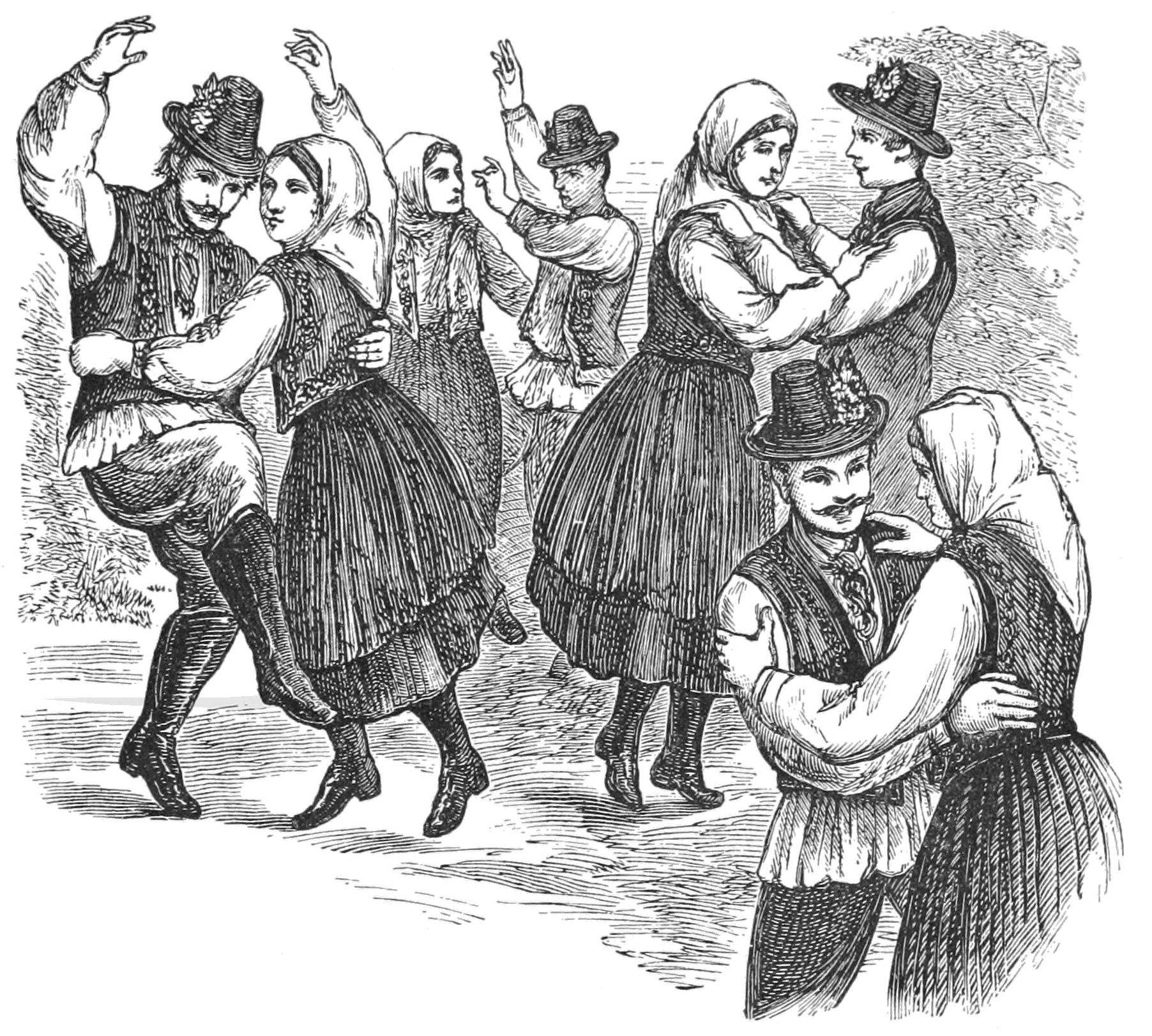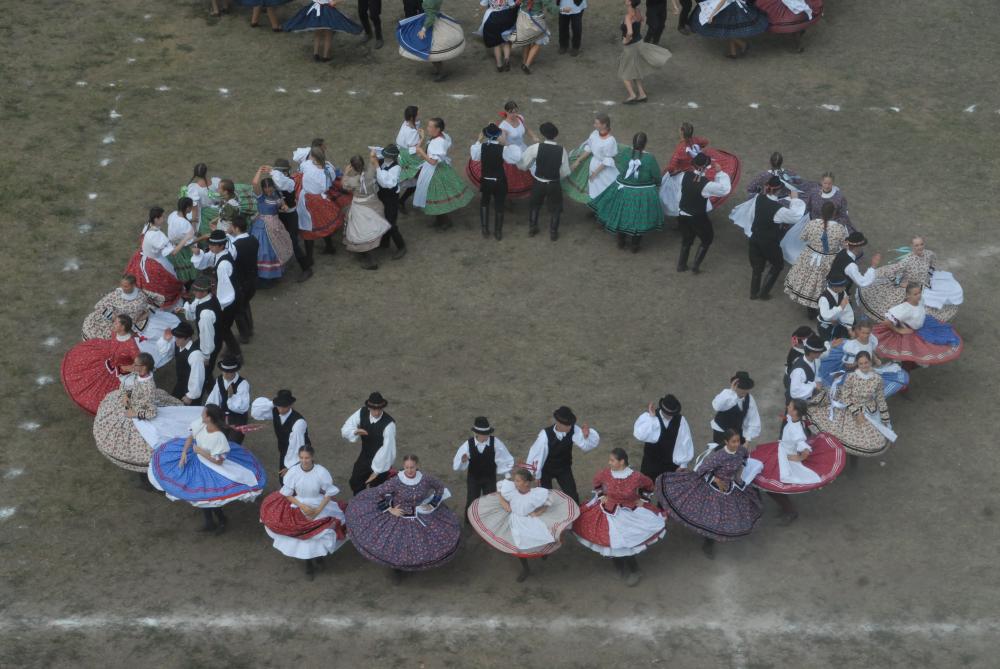|
Hungarian Dance
Hungarian dance refers to the folk dances practised and performed by the Hungarians, both amongst the populations native to Hungary and its neighbours, and also amongst the Hungarian diaspora. According to György Martin, a prominent folklore expert, Hungarian dances can be divided into two categories. The first refers to dances performed in the middle ages while the second relates to the 18th and 19th century. Hungarians have been noted for their "exceptionally well developed sense of rhythm".Karoly Viski (1937) ''Hungarian Dances''; p. 8 In the mid-19th century, Musicologist Theodor Billroth performed tests with troops of various nationalities stationed in Vienna and found that the Hungarian troops outperformed others in keeping time with music. Improvisation and energetic movements are often mentioned as being characteristic of Hungarian dance.György Martin (1974) ''Hungarian Folk Dances''. Gyoma: Kner Printing House, p. 15. Daniel Berzsenyi wrote, "Its secret laws are not order ... [...More Info...] [...Related Items...] OR: [Wikipedia] [Google] [Baidu] |
Csárdás
Csárdás (, ; ), often seen as Czárdás, is a traditional Hungarian folk dance, the name derived from ' (old Hungarian term for roadside tavern and restaurant). It originated in Hungary and was popularized by bands in Hungary and neighboring lands of Slovenia, Burgenland, Croatia, Transylvania, Slovakia and Moravia, as well as among the Banat Bulgarians, including those in Bulgaria. History The origin of the csárdás can be traced back to the 18th century Hungarian music genre the '' verbunkos'', where the 'verbunk' was used as a recruiting dance by the Austrian army. The csárdás is characterized by a variation in tempo: it starts out slowly ('' lassú'') and ends in a very fast tempo ('' friss'', literally "fresh"). There are other tempo variations, called ''ritka csárdás'', ''sűrű csárdás'' and ''szökős csárdás''. The music is in or time. The dancers are both male and female, with the women dressed in traditional wide skirts, which form a distinctive shap ... [...More Info...] [...Related Items...] OR: [Wikipedia] [Google] [Baidu] |
Legényes
A legényes (in Hungarian) or feciorească (in Romanian) is a men's solo dance done by Transylvanian people (in Hungarian ethnic) living in the Kalotaszeg/Țara Călatei, Szilágyság/Sălaj and Mezőség/Câmpia Transilvaniei regions of Transylvania, roughly the region around Cluj. Although usually danced by young men, it can be also danced by older men. The dance is performed freestyle usually by one dancer at a time in front of the band. Women participate in the dance by standing in lines to the side and sing/shout verses while the men dance. Each lad does a number of points (dance phrases) typically 4 to 8 without repetition. Each point consists of 4 parts, each lasting 4 counts. The first part is usually the same for everyone (there are only a few variations). Styles * legényes / feciorească (Kalotaszeg) * sűrű tempó (Szék) * sűrű magyar or sűrű fogásolás (Mezőség) * pontozó / ponturi (Küküllő-mente) * târnăveană or korcsos (Mezőség) * figurázó (Szi ... [...More Info...] [...Related Items...] OR: [Wikipedia] [Google] [Baidu] |
Austria-Hungary
Austria-Hungary, often referred to as the Austro-Hungarian Empire,, the Dual Monarchy, or Austria, was a constitutional monarchy and great power in Central Europe between 1867 and 1918. It was formed with the Austro-Hungarian Compromise of 1867 in the aftermath of the Austro-Prussian War and was dissolved shortly after its defeat in the First World War. Austria-Hungary was ruled by the House of Habsburg and constituted the last phase in the constitutional evolution of the Habsburg monarchy. It was a multinational state and one of Europe's major powers at the time. Austria-Hungary was geographically the second-largest country in Europe after the Russian Empire, at and the third-most populous (after Russia and the German Empire). The Empire built up the fourth-largest machine building industry in the world, after the United States, Germany and the United Kingdom. Austria-Hungary also became the world's third-largest manufacturer and exporter of electric home appliances, ... [...More Info...] [...Related Items...] OR: [Wikipedia] [Google] [Baidu] |
Verbunkos
Verbunkos (), other spellings being ''Verbounko'', ''Verbunko'', ''Verbunkas'', ''Werbunkos'', ''Werbunkosch'', ''Verbunkoche''; sometimes known simply as the hongroise or ungarischer Tanz is an 18th-century Hungarian dance and music genre. The verbunkos is typically in a pair of sections, slow (''lassú''), with a characteristic dotted rhythm, and fast (''friss''), with virtuosic running-note passages. In some cases, this slow-fast pair alternates at greater length. The name is derived from the German word ''Werbung'', a noun derived from the verb ''werben'' that means, in particular, "to recruit"; verbunkos—recruiter. This music and dance was played during military recruiting before the Habsburg Emperors, who were also Kings of Hungary, introduced conscription in 1849. A group of a dozen hussars performed the dance in different parts, with the leading sergeant opening with slow movements, then the lower officers joining for more energetic parts, and the youngest soldiers con ... [...More Info...] [...Related Items...] OR: [Wikipedia] [Google] [Baidu] |
Karikázó
Karikázó is a Hungarian folk dance traditionally performed by women. It is a circle dance in time, traditionally to a cappella rather than instrumental music.Somogyi Karikazo. http://www.dunav.org.il/dance_notes/somogyi_karikazo.pdf References Hungarian styles of music Hungarian dances Circle dances {{Folk-dance-stub ... [...More Info...] [...Related Items...] OR: [Wikipedia] [Google] [Baidu] |
Transylvania
Transylvania ( ro, Ardeal or ; hu, Erdély; german: Siebenbürgen) is a historical and cultural region in Central Europe, encompassing central Romania. To the east and south its natural border is the Carpathian Mountains, and to the west the Apuseni Mountains. Broader definitions of Transylvania also include the western and northwestern Romanian regions of Crișana and Maramureș, and occasionally Banat. Transylvania is known for the scenery of its Carpathian landscape and its rich history. It also contains Romania's second-largest city, Cluj-Napoca, and other iconic cities and towns such as Brașov, Sibiu, Târgu Mureș, Alba Iulia and Sighișoara. It is also the home of some of Romania's UNESCO World Heritage Sites such as the Villages with fortified churches, the Historic Centre of Sighișoara, the Dacian Fortresses of the Orăștie Mountains and the Roșia Montană Mining Cultural Landscape. It was under the rule of the Agathyrsi, part of the Dacian Kingdom (168 BC–106 ... [...More Info...] [...Related Items...] OR: [Wikipedia] [Google] [Baidu] |
Middle Ages
In the history of Europe, the Middle Ages or medieval period lasted approximately from the late 5th to the late 15th centuries, similar to the post-classical period of global history. It began with the fall of the Western Roman Empire and transitioned into the Renaissance and the Age of Discovery. The Middle Ages is the middle period of the three traditional divisions of Western history: classical antiquity, the medieval period, and the modern period. The medieval period is itself subdivided into the Early, High, and Late Middle Ages. Population decline, counterurbanisation, the collapse of centralized authority, invasions, and mass migrations of tribes, which had begun in late antiquity, continued into the Early Middle Ages. The large-scale movements of the Migration Period, including various Germanic peoples, formed new kingdoms in what remained of the Western Roman Empire. In the 7th century, North Africa and the Middle East—most recently part of the Ea ... [...More Info...] [...Related Items...] OR: [Wikipedia] [Google] [Baidu] |
Ugrós
The Ugrós is an athletic Hungarian couples' jumping dance in meter with an off-beat accent similar to polkas or hasaposerviko. Its origins lay in weapon dances from the Middle Ages. Dunántúli Ugros Dunántúli Ugros is a couples' folk dance from Transdanubia (''Dunántúl'' in Hungarian), the western part of Hungary. See also * Hopak * Hasapiko * Yalli Halay is the national dance of Turkey and a regional category of folk dance styles in central, southern, eastern, and southeastern regions of the country. It is mainly performed by Turks, Arabs, and Kurds in Turkey. Halay and similar dances are ... References Hungarian styles of music Hungarian dances {{Dance-stub ... [...More Info...] [...Related Items...] OR: [Wikipedia] [Google] [Baidu] |
Jászszentandrás
Jászszentandrás is a village in Jász-Nagykun-Szolnok county, in the Northern Great Plain region of central Hungary. Geography It covers an area of . Population It has a population Population typically refers to the number of people in a single area, whether it be a city or town, region, country, continent, or the world. Governments typically quantify the size of the resident population within their jurisdiction using a ... of 2440 people (2015). References External links Official sitein Hungarian Populated places in Jász-Nagykun-Szolnok County Jászság {{Jasz-geo-stub ... [...More Info...] [...Related Items...] OR: [Wikipedia] [Google] [Baidu] |
PSM V41 D775 Csardas Hungarian Folk Dance
PSM, an acronym, may refer to: Organizations * Sepaktakraw Association of Malaysia ( ms, Persatuan Sepaktakraw Malaysia; PSM), a national governing body in Malaysia. * Pakistan School Muscat, a Pakistani co-educational institute in Oman * Palestine Solidarity Movement, a student organization in the United States * Panhellenic Socialist Movement, a centre-left party in Greece * Parti Sosialis Malaysia, a socialist political party in Malaysia * PlayStation: The Official Magazine, a magazine originally known as PlayStation Magazine or PSM * Ponce School of Medicine, a post-graduate medical school located in Ponce, Puerto Rico * Power Systems Mfg, a subsidiary of Alstom, specializing in aftermarket gas turbine servicing for power generating industry. * ''Poznańska Spółdzielnia Mieszkaniowa'', a housing cooperative administering most of the Piątkowo district of Poznań, Poland * PSM3, a UK video game magazine specializing in Sony consoles * PSM Makassar, a football club that pl ... [...More Info...] [...Related Items...] OR: [Wikipedia] [Google] [Baidu] |
Hungarians
Hungarians, also known as Magyars ( ; hu, magyarok ), are a nation and ethnic group native to Hungary () and historical Hungarian lands who share a common culture, history, ancestry, and language. The Hungarian language belongs to the Uralic language family. There are an estimated 15 million ethnic Hungarians and their descendants worldwide, of whom 9.6 million live in today's Hungary. About 2–3 million Hungarians live in areas that were part of the Kingdom of Hungary before the Treaty of Trianon in 1920 and are now parts of Hungary's seven neighbouring countries, Slovakia, Ukraine, Romania, Serbia, Croatia, Slovenia, and Austria. Significant groups of people with Hungarian ancestry live in various other parts of the world, most of them in the United States, Canada, Germany, France, the United Kingdom, Chile, Brazil, Australia, and Argentina. Hungarians can be divided into several subgroups according to local linguistic and cultural characteristics; subgroups with dist ... [...More Info...] [...Related Items...] OR: [Wikipedia] [Google] [Baidu] |




